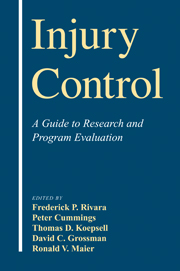Book contents
- Frontmatter
- Contents
- List of Contributors
- 1 An Overview of Injury Research
- 2 Classifying and Counting Injury
- 3 Measurement of Injury Severity and Co-morbidity
- 4 Data Linkages and Using Administrative and Secondary Databases
- 5 Rates, Rate Denominators, and Rate Comparisons
- 6 Data Collection Methods
- 7 Selecting a Study Design for Injury Research
- 8 Qualitative Methods in Injury Research
- 9 Randomized Trials
- 10 Cohort Studies in Injury Research
- 11 Case–Control Studies in Injury Research
- 12 Ecologic Studies
- 13 Case Series and Trauma Registries
- 14 Systematic Reviews of Injury Studies
- 15 Evaluating an Injury Intervention or Program
- 16 The Development of Clinical Decision Rules for Injury Care
- 17 Trauma Performance Improvement
- 18 Measuring Disability and Quality of Life Postinjury
- 19 Economic Evaluation of Injury Control
- 20 Ethical Issues
- Index
19 - Economic Evaluation of Injury Control
Published online by Cambridge University Press: 16 October 2009
- Frontmatter
- Contents
- List of Contributors
- 1 An Overview of Injury Research
- 2 Classifying and Counting Injury
- 3 Measurement of Injury Severity and Co-morbidity
- 4 Data Linkages and Using Administrative and Secondary Databases
- 5 Rates, Rate Denominators, and Rate Comparisons
- 6 Data Collection Methods
- 7 Selecting a Study Design for Injury Research
- 8 Qualitative Methods in Injury Research
- 9 Randomized Trials
- 10 Cohort Studies in Injury Research
- 11 Case–Control Studies in Injury Research
- 12 Ecologic Studies
- 13 Case Series and Trauma Registries
- 14 Systematic Reviews of Injury Studies
- 15 Evaluating an Injury Intervention or Program
- 16 The Development of Clinical Decision Rules for Injury Care
- 17 Trauma Performance Improvement
- 18 Measuring Disability and Quality of Life Postinjury
- 19 Economic Evaluation of Injury Control
- 20 Ethical Issues
- Index
Summary
Purposes of Economic Evaluation
As the problem of injury garners increasing attention in the public and private sectors of the economy, the amount of resources dedicated to the prevention, treatment, and rehabilitation of injuries can be expected to grow. These resources are the scarce labor and capital that could be applied to other productive uses in the economy (e.g., better housing or education) if they were not allocated to the field of injury control. Even if we restrict the allocation issue to the injury control field (e.g., prevention vs. treatment, unintentional vs. intentional injuries, injuries to adults vs. injuries to children, and technological vs. behavioral interventions), resource-allocation decisions regarding which interventions to implement still need to be made. Currently, these types of decisions are often made informally or implicity, without analytical consideration of what would be in the best interests of society.
Effectiveness is one of the few objective criteria applied in the selection of recommended best practices (US Preventive Task Force, 1996). Efficiency, that is the relationship between the effectiveness of an intervention and the resources needed to implement it, is more rarely used as a selection criterion.
The purpose of economic evaluation is to assist decision makers in allocating resources efficiently by taking into account the costs and effects (or consequences) of an intervention compared with the status quo or the most-likely alternative to the intervention. Efficiency considerations become even more necessary as the number of effective interventions continues to grow, exceeding the resources available to implement all of them.
Keywords
- Type
- Chapter
- Information
- Injury ControlA Guide to Research and Program Evaluation, pp. 270 - 282Publisher: Cambridge University PressPrint publication year: 2000
- 1
- Cited by

